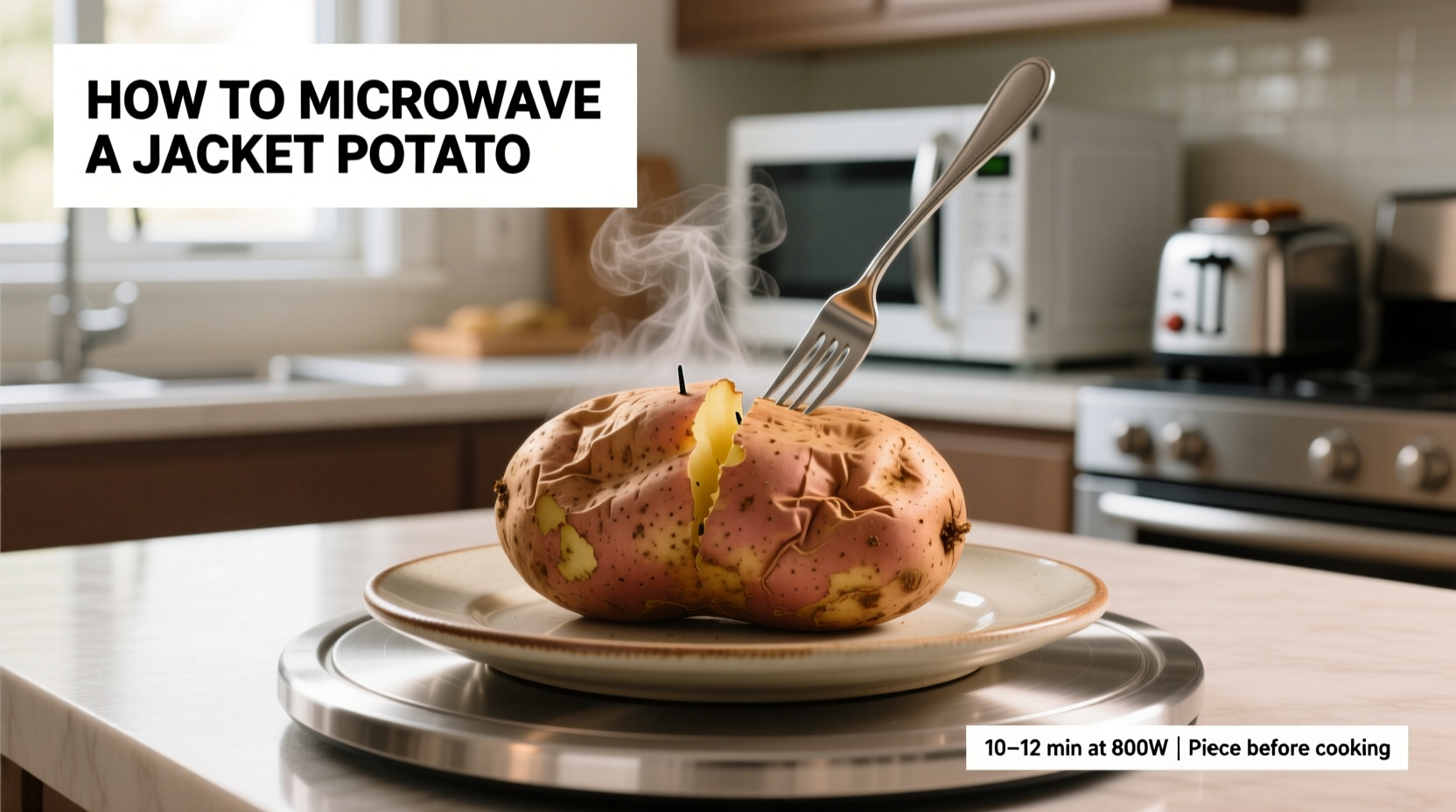The Fastest Way to Perfect Microwave Jacket Potatoes
When you're craving a fluffy baked potato but don't have 45-60 minutes to wait for oven baking, microwaving delivers restaurant-quality results in a fraction of the time. This method preserves more nutrients than boiling while creating that signature fluffy interior with slightly crisp skin. Unlike oven-baked versions, microwave jacket potatoes maintain optimal moisture without drying out, making them ideal for busy weeknights or when you need a quick, nutritious side dish.
Why Microwaving Beats Other Cooking Methods
Microwaving jacket potatoes isn't just faster—it actually creates superior texture in many cases. The rapid steam generation inside the potato breaks down starches more evenly than conventional baking, yielding consistently fluffy results without dry spots. Food science research from the USDA Food Safety and Inspection Service confirms that microwave cooking preserves up to 25% more water-soluble vitamins compared to boiling.
| Cooking Method | Time Required | Texture Quality | Nutrient Retention |
|---|---|---|---|
| Microwave | 8-12 minutes | Fluffy interior, slightly crisp skin | High (minimal water exposure) |
| Oven Baking | 45-60 minutes | Crisp skin, fluffy interior | Moderate (some nutrient loss) |
| Boiling | 20-25 minutes | Waterlogged, less fluffy | Low (water-soluble vitamins leach) |
Your Step-by-Step Microwave Jacket Potato Guide
Preparation: Setting Up for Success
Start with medium-sized russet potatoes (6-8 ounces each) for most consistent results. Larger potatoes require significantly longer cooking times and often cook unevenly. Thoroughly scrub potatoes under cold running water using a vegetable brush—this removes dirt while preserving the nutrient-rich skin. Never skip the piercing step: use a fork to make 4-5 deep punctures around each potato. This critical safety step prevents steam buildup that could cause explosive ruptures in your microwave.
Cooking Process: Timing and Technique
Place potatoes directly on the microwave turntable or on a microwave-safe plate. For one medium potato, cook on high power for 5-7 minutes. For two potatoes, increase to 9-11 minutes. Always flip potatoes halfway through cooking to ensure even heat distribution. The exact time depends on your microwave's wattage—700W models require about 20% longer than 1000W units. When done, the potato should feel soft when gently squeezed (using oven mitts!) and a fork should slide in with no resistance.

Finishing Touches for Restaurant-Quality Results
Let potatoes rest for 2 minutes after cooking—this allows residual heat to finish the cooking process and makes handling safer. To enhance texture, slice open and fluff the interior with a fork before adding toppings. For slightly crispier skin, place finished potatoes under the broiler for 2-3 minutes. The BBC Good Food test kitchen recommends rubbing potatoes with olive oil and sea salt immediately after cooking for optimal flavor development.
When Microwaving Works Best (And When to Choose Alternatives)
Microwaving excels for weeknight meals, single servings, or when you need potatoes quickly for salads or soups. However, for special occasions where presentation matters, oven baking creates superior crispy skin. The Food Safety and Inspection Service emphasizes that microwave cooking is perfectly safe as long as potatoes reach an internal temperature of 205°F (96°C). Avoid microwaving potatoes intended for twice-baked preparations—the skin won't crisp properly for refilling.
Troubleshooting Common Issues
Problem: Potato is hard in the center
Solution: Continue cooking in 1-minute increments until fork-tender. Larger potatoes may need up to 15 minutes total.
Problem: Skin is soggy
Solution: Pat dry with paper towels immediately after cooking, or finish under the broiler for 2-3 minutes.
Problem: Potato exploded in microwave
Solution: Always pierce deeply with a fork (4-5 times) to allow steam escape. Never wrap potatoes completely in plastic.
Pro Tips for Perfect Results Every Time
For extra-fluffy results, microwave potatoes on a paper towel to absorb excess moisture. When cooking multiple potatoes, arrange them in a circle with space between each to ensure even cooking. Leftover potatoes reheat beautifully—store in an airtight container for up to 4 days. For meal prep efficiency, cook several potatoes at once and refrigerate for quick lunches throughout the week. Remember that microwaved potatoes continue cooking slightly after removal, so slightly undercook if serving immediately.
Frequently Asked Questions
How long should I microwave two jacket potatoes?
Two medium jacket potatoes (6-8 ounces each) typically require 9-11 minutes on high power in a standard 1000W microwave. Place them on opposite sides of the turntable, flip halfway through cooking, and check for doneness by inserting a fork. Larger potatoes or lower-wattage microwaves may need additional time.
Can I wrap my jacket potato in microwave-safe plastic wrap?
Yes, but with caution. Loosely tent the potato with microwave-safe plastic wrap, leaving one corner open for steam to escape. Never seal tightly as pressure buildup could cause dangerous explosions. For best results, place a paper towel between the potato and plastic to absorb excess moisture while maintaining steam for even cooking.
Why do I need to let the potato rest after microwaving?
Resting for 2 minutes allows residual heat to finish cooking the center evenly while making the potato safer to handle. During this time, starches continue to set and moisture redistributes throughout the potato, creating that perfect fluffy texture. Cutting too soon releases valuable steam that keeps the interior moist.
How can I tell if my microwave jacket potato is fully cooked?
A perfectly cooked jacket potato will yield easily when pierced with a fork, feel soft when gently squeezed (using protection!), and reach an internal temperature of 205°F (96°C). The skin should separate slightly from the flesh when squeezed. Undercooked potatoes feel firm in the center, while overcooked ones become waterlogged and collapse when handled.
Can I microwave a jacket potato without piercing it?
No, piercing is essential for safety. Potatoes contain significant moisture that turns to steam during cooking. Without vent holes, pressure builds until the potato explodes, creating a dangerous mess inside your microwave. Always make 4-5 deep punctures with a fork before cooking—this simple step prevents accidents while ensuring even cooking.











 浙公网安备
33010002000092号
浙公网安备
33010002000092号 浙B2-20120091-4
浙B2-20120091-4